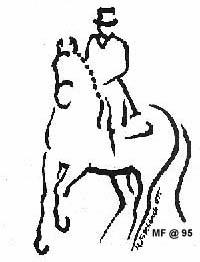
The word dressage refers to the training of a horse. To dress a horse means to train it.
A "dressage horse" is generally known to be any horse who competes in dressage. However, every horse who is taught to carry a rider is in fact being given some level of dressage training, although the rider may not refer to the training as dressage work. Often dressage training is simple called "flat work" or "ring work".
Throughout the training and development of the dressage horse, we are slowly and carefully working towards several goals which interplay and overlap:
Horses who compete in dressage competition must perform a prescribed test which consists of several "movements". Each movement is scored 0 to 10 by a dressage judge. After the test is complete, the judge also gives scores for four "general impressions":
The general impressions scores should reflect the scores giving throughout the test, however, this is not always the case. A horse can show good gaits but perform a fairly bad test. Also, a rider on a very disobedient horse can gain points for proper application of their skills.
0 -- Not executed 4 -- Insufficient 8 -- Good
1 -- Very bad 5 -- Sufficient 9 -- Very good
2 -- Bad 6 -- Satisfactory 10 -- Excellent
3 -- Fairly bad 7 -- Fairly good
Along with each score, the judge can provide a comment which helps the rider understand why a certain score was given, or what was needed to get a better score.
From this competitor's point of view, the scores can be interpreted this way:
0-3 -- Needs serious fixing
4 -- Need to improve here
5 -- Marginal, work on this
6 -- Okay, what we aim for
7 -- Nice job
8 -- Wowwee!!
9-10 -- Unbelievable!!!
The final score of the test is a percentage of points earned out of a perfect test of all 10's (never seen). So, a test with all 6's would be 60%. A test with an equal number of 5's and 6's would be a 55%. A test with all 7's would be a 70%.
A score of 60% is okay, the base score to aim for. Less than that and you've got work to do. More than that and you're doing well. Scores in the 70's are not common and well worth being quite proud of. Scores in the 80's are very rare and usually are only earned in Musical Freestyle's (Kurs) by top horse and rider combinations or in Young Horse classes.
Many dressage riders dream of the day they will get to "feel" the advanced movements. Usually, those first experiences will be during a lesson on a "school master", a horse who already knows how to perform the movements. After learning how to perform the movement, and how it should feel when done properly, the rider can then try to teach the movement to their own horse.
I highly recommend you check out Karen Pautz's website, http://www.ridinghabit.com/guide/. There, you will find some short video clips of some of the advanced dressage movements seen in FEI and Olympic level competitive dressage as performed by some international riders. It's a great website.